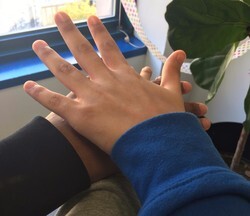This is my first post since the election. Like many of you, I’ve spent a good portion of the days since November 8th thinking about what the election of Donald Trump means for my future, the future the people I love, and the future of the young people I teach.
I recognize that you come to this particular post with your own perspective on what happened and why it happened. I also recognize that there are thousands of people who are thinking, speaking, and writing about the election who are smarter and more capable than I am of explaining the complicated phenomena at play in our particular political moment.
I don’t mention this to be self-effacing or as a cop out. This is an opinion blog and I’m happy to share my opinion that Hillary Clinton would have been a strong and effective president. Furthermore, I’m happy to share my opinion that the racist, sexist, and dangerous campaign rhetoric of Donald Trump should have disqualified him from the position if his utter lack of experience did not.
Of course, no one will (or should) be convinced of those positions by this post.
While I may not be a political insider or historian, I do have a front row seat to a world which provides insight into one of the key philosophical differences between the Trump and Clinton campaigns: are we a nation in need of walls or one in which we are “stronger together?”
Unlike many teachers (most in the city where I teach), I work at an integrated school. Nationally, our schools are more segregated today than they were 40 years ago (at the beginning of federally mandated desegregation programs).
In an op-ed after the election, United Federation of Teachers President Michael Mulgrew published a piece about our school and our fight to stay integrated in a segregated world. The article’s thesis and the role of diversity in our school mission are the same: “diversity is a strength and an asset that can be nurtured.”

My students learn more effectively because they learn alongside people who see the world, speak the world, and experience the world in different ways than they do. We talk together about the problems they face. We think together about the problems the world faces.
When students do a project about art we get to hear about artistic styles in different communities and ethnic groups. When we talk about future careers, students share the different hopes and dreams that diverse people have for our world. When we grapple with sad realities from our past we do so as the descendants of people on many sides of the same situation.
For me, “stronger together” is not campaign slogan to be marched out for a few months and then put back on the shelf. Our school is stronger every day because we are in it together.
I realize that the ethnic and racial diversity of my particular “together” may be greater than the “togethers” that many of you experience, but I don’t believe that my experience is unique. Aren’t all school communities made stronger by the diverse perspectives within them? The student who sees something different in a problem makes the class think more about it. The student who has traveled to a different place can share a new idea that improves a discussion. The student who has different taste in art or music pushes the boundaries of classmates’ expressions. Different perspectives create opportunities for learning. This is what we all see as teachers if we are looking for it.
The “stronger together” candidate may have lost on November 8th, but those of us who experience this reality every day know that it is still a winning message.
As we continue to grapple with the election and it’s outcomes, I hope that you’ll share the ways in which togetherness has strengthened your school: with students, with families, with colleagues and with community members. We shouldn’t let anyone ever forget this message.
Photo by author